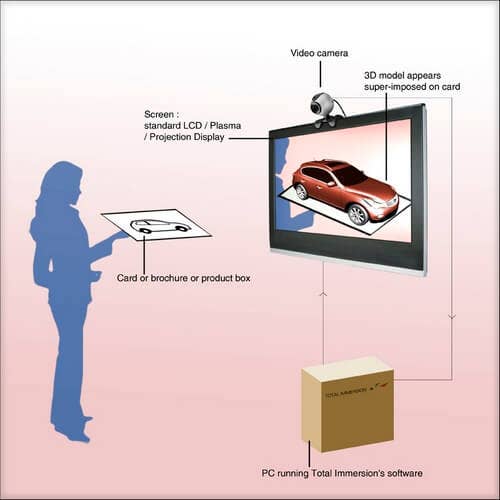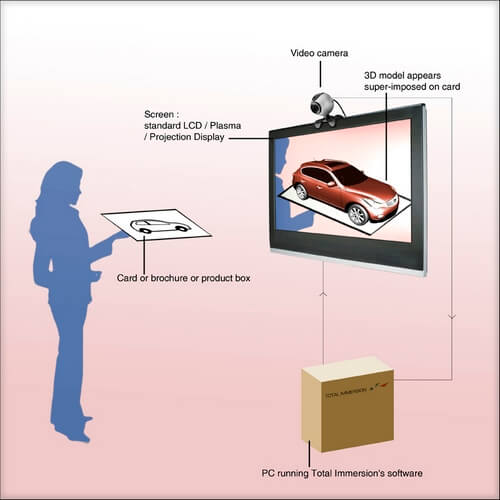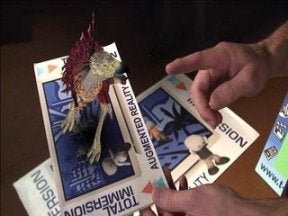Reality – Now With Augmentation

Share
Somewhere between the harshness of reality and the fantasy of virtual reality lies the domain of Augmented Reality (AR). The French company Total Immersion's AR technology uses camera capture and 3D imaging techniques to blend surrounding and simulated environments in real-time. You've probably seen the videos floating around You Tube -- people hold simple pieces of paper up to their web cameras and suddenly cool cars or a baseball player appear on the screen, seemingly right on top of the paper. The mash of real and virtual gives the illusion that both are occurring in the same space. One look at these stunning effects and you have a hard time believing it's real, which it isn't, and you can't help wanting to learn more. If you haven't seen the videos already, check out what you're missing below:
AR videos have been making the rounds on the Internet recently in part due to their nearly seamless blending of the captured and constructed images. Without this real-time blending, Augmented Reality would be completely redundant with the CGI movies that have been coming out of Hollywood for years. With the real-time blending, Total Immersion has opened the door for interaction between the audience and virtual environment. That interactive ability is what will transform AR from a novelty to a world-wide phenomenon.

Some companies are predisposed to benefit from the AR technology.
Collectible trading card games and sports memorabilia have jumped at the chance for interactive collectibles. Topps (the baseball card giant) launched AR products in March, shown in this demonstration video:
Be Part of the Future
Sign up to receive top stories about groundbreaking technologies and visionary thinkers from SingularityHub.


The Reality of the Situation
In the short term, AR will primarily be seen in two venues: interactive marketing and extended-content media. Interactive marketing has already proven useful: Focus Feature's stop motion movie Coraline used an advertising campaign (in selected cities) where people on the street could see themselves with button eyes. General Electric's new web campaign, plug into the smart grid, allows users to explore their new energy solutions using AR. Extended-content media will encompass all the books, DVD cases, and other merchandise that will boost sales by including interactive AR portions. Already, Total Immersion is working with childrens' books publishers to create products that can either be read as normal books or read along side the computer for interactive stories.
Total Immersion has developed marker-less tracking for its camera capture software. This means that any object (not just specially tagged objects) can be viewed and augmented. In the future, your mobile phone could take a picture of any object and provide information or overlapping video as you desire. Already, advertising applications are being implemented so that you can take a snapshot of a product you see and have its purchasing information appear instantly on your mobile device.

In the long term, AR is a solid step to closing the gap between watching and experiencing content. Already Total Immersion has teamed up with Futuroscope (a French amusement park) and created an interactive attraction that projects artificial zoos right before your eyes. The next step will be to take the technology out of the entertainment industry and into the information age. Imagine wearing special glasses that show the height, weight, and costs of objects you see. Or, you could sit in a car and have hazards highlighted on your windshield and maps appear on the road ahead of you. As cameras become smaller and clearer, your biological eyes could be enhanced with AR images and informatics. Military applications for AR are plentiful: assisted aiming, tactical information on targets, comparing faces to known-combatant lists, etc.
All this potential from a company that is still building after 10 years. Starting in 1999, founders Bruno Uzzan and Valentin Lefevre developed AR from an idea into a successful international company. And they continue to grow, with a new office in Los Angeles. For those who doubt that Total Immersion and AR will extend beyond a mere novelty, let me point out that some of the first applications for AR were in model design and simulation for BMW and GM. While Total Immersion may have come to your attention for its cool videos and customer interactivity "wow" factor, its future is likely to be much more impressive. AR is going to make our world a little less real and a lot more virtual.
Related Articles

How Scientists Are Growing Computers From Human Brain Cells—and Why They Want to Keep Doing It

These Brain Implants Are Smaller Than Cells and Can Be Injected Into Veins

This Wireless Brain Implant Is Smaller Than a Grain of Salt
What we’re reading